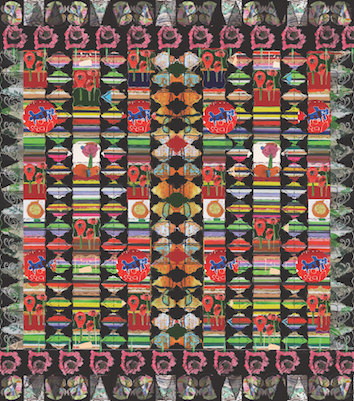The School Teacher and the Art Museum: A Multi- Case Study of Online Canadian Art Museum Teacher Resources
Main Article Content
Abstract
This study seeks to better understand the online resources and lesson contents that Canadian art museums offer secondary school art teachers. The author conducted a content analysis of online teacher resources and lessons developed by four Canadian art museums during 2016. By looking at the various resources through the lens of a high school teacher/researcher, the author highlighted how these resources presented differences in curriculum and fostered self-reflection in students. The relationship between the art museum and the school teacher was examined. To better understand this relationship, further research on online resources developed by museums to increase pedagogical possibilities should be conducted.
Key Words: Teacher; Museum; Online Teaching Resources; Art Education
Downloads
Article Details

This work is licensed under a Creative Commons Attribution-ShareAlike 4.0 International License.
The copyright notice is CC BY SA.
This license lets others remix, tweak, and build upon your work even for commercial purposes, as long as they credit you and license their new creations under the identical terms. All new works based on yours will carry the same license. Thus any derivatives will also allow commercial use. For example, if someone translates your article into French, the French version of the article will also have to be shared under a CC BY SA license.
References
Anderson, T. and Milbrandt, M. (1998). Authentic Instruction in Art: Why and How to Dump the School Art Style. Visual Arts Research, 24, 1, 13-20.
Art Gallery of Alberta (2016). Lesson Plans. Retrieved from: www.youraga.ca/
Art Gallery of Ontario (2016). Lesson Plans. Retrieved from: www.ago.net
Berry, N. (1998). A Focus on Art Museum School Collaborations. Art Education,51, 2, 8-14.
Plano Clark, V. L., & Creswell, J. W. (2008). The mixed methods reader.
Duh, M. (2015). The Function of Museum Pedagogy in the Development of Artistic Appreciation. Journal of Elementary Education, 8, 4, 87-101.
Efland, A. (1976). The School Art Style: A Functional Analysis. Studies in Art Education, 17,2, 7-44.
Gilmore, A., & Rentschler, R. (2002). Changes in museum management: A custodial or marketing emphasis?. Journal of management development, 21(10), 745-760.
Gray-Rodriquez, C. (2015). An Art Teacher’s Perspective: The Value of Museum Resources to the Common Core. Journal of Museum Education, 40,3, 250-256.
Gude,O. (2013). New School Art Styles: The Project of Art Education. Art Education, 6-15.
Hein, G. (2011). Museum Education. In Sharon Macdonald (Ed.), A Companion of Museum Studies (pp. 340-352). Singapore: Willey-Blackwell.
Hooper-Greenhill, E. (2000). Changing Values in the Art Museum: rethinking communication and learning. International Journal of Heritage Studies, 6,1, 9-31.
Knutson, K., Crowley, K., Russell, J., & Steiner, M. A. (2011). Approaching Art Education as. Studies in Art Education, 52(4), 326-338.
Lemon, N. And Gravis, S. (2014). Perceptions of Pre-Service Teachers Value of Art Museums
Matthewson-Mitchell, D. (2008). Exploring Alternative Pedagogical Terrain: Teaching and Learning in Art Museums. International Journal of Pedagogy and Learning, 4,5, 74-89.
Mayer, M. (2005). A Postmodern Puzzle: Rewriting the Place of the Visitor in Art Education. Studies in Art Education, 46,4, 356-368.
Mazzola, L.(2015). MOOCs and Museums: Not Such Strange Bedfellows. Journal of Museum Education, 40, 2, 159-170.
Miller, J. and Seller, W. (1990). The curriculum process. Curriculum: Perspectives and practice (pp.3-15). Toronto: Coop Clark Pitman.
Novak, K. and Hulsbosch, M. (2013). Examining Museum Education Kits Using a Cultural Capital Lens: The Positioning of Visual Arts Teachers and their students within Museum Education Kits. The International Journal of The Inclusive Museum, 5, 37-48.
Pallas, J., & Economides, A. A. (2008). Evaluation of art museums' web sites worldwide. Information Services & Use, 28(1), 45-57.
Peare, H. (2006). Chapter 1-Introduction. From drawing to visual culture: A history of art education in Canada (pp.3-20). Montreal: McGill-Queens University Press.
Pinar, W. (2012). From autobiography to allegory. What is curriculum theory? (pp.43-66). New York: Routledge.
Quinlan-Gagnon, W. (2013). Art Museums Online: Using Interactive Websites to Build Cultural Capital. The International Journal of the Inclusive Museum,5, 24-32.
Titscher, S, Meyer, M., Wodak, R. and Vetter,E. (2000). Methods of Text and Discourse Analysis. Thousands Oaks: Sage Publications.
Varisco, R., & Cates, W. (2005). Survey of Web–based educational resources in selected US art museums. First Monday, 10(7).
Vancouver Art Gallery (2016). Lesson Plans. Retrieved from: www.vanartgallery.bc.ca/
Wetterlund, K. (2008). Flipping the Field Trip: Bringing the Art Museum to the Classroom. Theory into Practice, 47,1, 110-117.
Williams, B. (1996). An Examination of Art Museum Education Practices Since 1984. Studies in Art Education, 38, 1, 34-49.
Winnipeg Art Gallery. (2016). Lesson Plans. Retrieved from: www.wag.ca
Yin, R. K. (2002). Applications of Case Study Research Second Edition (Applied Social Research Methods Series Volume 34).
Yuan, Y., Stephenson, P., & Hickman, R. (2015). Museums as Alternative Settings for Initial Teacher Education: Implications of and Beyond the" Take One Picture" Program for Primary Art Education. Visual Arts Research, 41(1), 27-42.
Zeller, T. (1987). Museums and the Goals of Art Education. Art Education, 40, 1, 50-55.

